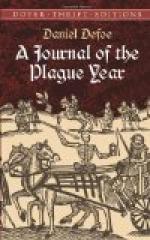* * * * *
Defoe had the ability to become a good scholar, and to acquire the elements of a good English style; but it is certain he never did. He never had time, or rather he never took time, preferring invariably quantity to quality. What work of his has survived till to-day is read, not for its style, but in spite of its style. His syntax is loose and unscholarly; his vocabulary is copious, but often inaccurate; many of his sentences ramble on interminably, lacking unity, precision, and balance. Figures of speech he seldom abuses because he seldom uses; his imagination, as noticed before, being extremely limited in range. That Defoe, in spite of these defects, should succeed in interesting us in his “Plague,” is a remarkable tribute to his peculiar ability as described in the preceding paragraph.
In the course of the Notes, the editor has indicated such corrections as are necessary to prevent the student from thinking that in reading Defoe he is drinking from a “well of English undefiled.” The art of writing an English prose at once scholarly, clear-cut, and vigorous, was well understood by Defoe’s great contemporaries, Dryden, Swift, and Congreve; it does not seem to have occurred to Defoe that he could learn anything from their practice. He has his reward. “Robinson Crusoe” may continue to hold the child and the kitchen wench; but the “Essay on Dramatic Poesy,” “The Battle of the Books,” and “Love for Love,” are for the men and women of culture.
* * * * *
The standard Life of Defoe is by William Lee (London, J.C. Hotten, 1869). William Minto, in the “English Men of Letters Series,” has an excellent short biography of Defoe. For criticism, the only good estimate I am acquainted with is by Leslie Stephen, in “Hours in a Library, First Series.” The nature of the article on Defoe in the “Britannica” may be indicated by noticing that the writer (Saintsbury) seriously compares Defoe with Carlyle as a descriptive writer. It would be consoling to think that this is intended as a joke.
Those who wish to know more about the plague than Defoe tells them should consult Besant’s “London,” pp. 376-394 (New York, Harpers). Besant refers to two pamphlets, “The Wonderful Year” and “Vox Civitatis,” which he thinks Defoe must have used in writing his book.
FOOTNOTES:
[1] At first, a weekly; with the fifth number, a bi-weekly; after the first year, a tri-weekly.
[2] Preface to his pamphlet entitled Street Robberies.
[3] For a very different estimate, see Saintsbury’s Selections from Defoe’s Minor Novels.
History
of
the plague in London.
It was about the beginning of September, 1664, that I, among the rest of my neighbors, heard in ordinary discourse that the plague was returned again in Holland; for it had been very violent there, and particularly at Amsterdam and Rotterdam, in the year 1663, whither, they say, it was brought (some said from Italy, others from the Levant) among some goods which were brought home by their Turkey fleet; others said it was brought from Candia; others, from Cyprus. It mattered not from whence it came; but all agreed it was come into Holland again.[4]




